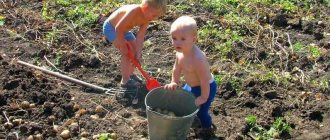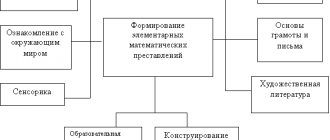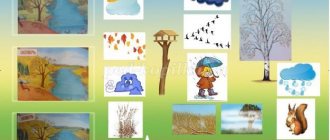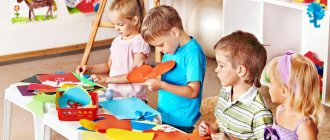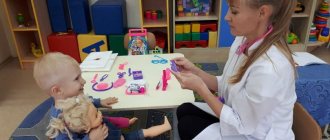Working with the nature calendar
In the middle group, it should be simple in terms of the material presented, and bright. With the help of a calendar, you can preserve in children’s memory for a long time interesting impressions from observations on the site, walks, excursions. The children's drawings reflecting what they saw are placed by the teacher on the calendar. In this case, you should select those that most accurately or figuratively represent what you saw.
The changing weather of the season also needs to be recorded. This can be done using the teaching toy “What is the weather today?”
On a thick piece of cardboard with a movable arrow fixed in the center, images of different weather conditions, but typical for a particular season, are placed or placed in transparent pockets for children's drawings. If you make the pictures interchangeable, you can use the calendar throughout the year. By combining a teaching toy with a tablet for children's drawings, already in the middle group you can create a corner for observing nature and the weather of the season. Keeping such calendars accustoms children to attention, develops the ability to observe, notice interesting and typical natural phenomena in spring, autumn, winter and summer.
In the older group of kindergarten, the nature calendar can be somewhat complicated, since children of the sixth year of life have increased the ability to perceive and comprehend natural phenomena, reflect what they see in drawings, as well as simple schematic images. Seasonal natural phenomena and weather conditions can be presented in the calendar in more detail using symbols . At the same time, the teacher should use the calendar not only as a means of recording children’s observations, but also to develop their ability to “read” the calendar.
Observation, which has increased by older preschool age, as well as the knowledge accumulated by children about weather variability, makes it possible to use a significant number (6-7) of conventional images of weather phenomena . For example, autumn weather phenomena can be represented by conventional images.
By the second half of the year, children in the older group have some basic knowledge about time (day, week). Therefore, the teacher can add a conventional image of the week (a strip with cells according to the number of days of the week) and teach children to independently note the weather conditions . Such fixed observations make it possible to show children the variability of weather, the dynamism of natural phenomena in a relatively short period of time, and also to consolidate ideas about the days of the week.
The nature calendar in the older group, as well as in the middle group, should include the most interesting drawings of children , reflecting their observations of the weather, the life of plants and animals, and people. The teacher should encourage children to make independent observations , express interest in this activity, evaluate it positively, create the need to sketch what they saw, talk about it using their drawing. Near the nature calendar it is good to have everything you need for drawing - paper, pencils or paints.
Nature calendars are designed differently in the older group. For example, at the beginning of the year, a calendar with a slight complication compared to the average group may be used. In it, plot pictures depicting various seasonal phenomena are replaced by conventional images. Images of new weather conditions are added.
In the second half of the year, children independently depict observed weather phenomena with conventional symbols and place them in the cell corresponding to the days of the week
Just like in previous groups, in the preparatory group a nature calendar is kept. It is placed in a corner of nature.
An important part of the calendar in the pre-school group is a sheet reflecting weather conditions during the month. In the cells corresponding to the days and weeks of the month, children record the weather conditions every day, using symbols for this. At the end of the month, with the help of the teacher, the number of sunny, cloudy, windy, rainy and other days is calculated and a conclusion is drawn about the prevailing weather conditions during the month.
In the second half of the year, it is recommended to note the weather conditions twice a day. To do this, each cell of the calendar is divided diagonally into two parts: morning and evening, and the weather is noted after a morning walk and before going out for an evening walk.
Forms of maintaining a calendar in a preparatory school group can be different. You can use a wall calendar .
The formation of ideas about the time of year can be carried out using a screen calendar, which has three columns: “Week”, “Weather”, “Wildlife”. The first column includes four vertical stripes indicating the days and weeks of the month. In order for children to better navigate the days of the week and learn their order, you can introduce colored images (for example, Monday - purple, Tuesday - blue, Wednesday - blue, Thursday - green, Friday - yellow, Saturday - orange and Sunday - red) .
In the second column (“Weather”), for one week (any week), the weather condition is noted daily using symbols that children can understand. Together with the children, the teacher can choose such icons and agree on what they mean. The third column contains children's drawings reflecting the state of plants, animals seen (birds, insects, animals) at a specific place in the kindergarten or in the immediate natural environment. This allows children to observe how the same place changes during a certain time of the year - spring, summer, autumn, winter - and draw a conclusion about the gradualness of the changes occurring, the increase or decrease in the effect of certain factors of inanimate nature that determine changes in living nature in season.
2. Environmental education in younger groups at different times of the year in classes and in everyday life, recording impressions.
Program content:introduce children to the calendar page for September, symbols; learn to draw icons, use stencils, carefully color the squares of the days of the week; develop an interest in observing nature.
Material:
calendar page for September, calendar page with symbols, white paper (for each child); stencils of icons, squares of days of the week, colored pencils.
Progress of the lesson
Part 1. The teacher arouses children's interest in autumn natural phenomena using poetry, riddles, and music. Then he introduces them to the “September” calendar page, draws attention to the lines, the cells of the days of the week, the weather, and the place for a drawing on the theme “Wildlife.” He says that today—Monday—observations of nature on the site will begin and that the results of observations should be sketched in the calendar using symbols (icons).
Part 2. Introducing children to icons. The teacher demonstrates the “Symbols” page, clarifies the sequence of days of the week, the color of each day, and examines with the children the icons indicating weather phenomena and animals.
To clarify the understanding of the symbolism of the icons, the teacher conducts game exercises with the children like: “I thought of a day of the week, which is indicated by blue (yellow or other) color. What day is it? Show it on your calendar." Or: “I wished for a sparrow. What icon does it represent? Show". And so on.
3rd part. Formation of practical skills in the depiction of icons. The teacher invites the children to use a stencil to draw 3-4 squares - “days of the week”, then paint over the contours in two ways - without a stencil and with it. Draws attention to the thoroughness of painting, specifies what day (by color) this or that child depicted.
Children practice drawing icons indicating weather phenomena, learn to draw a human figure, color this icon in accordance with the weather, and depict birds and insects.
Children draw new squares and learn to depict sunny or rainy weather in them, try to draw bird icons.
During the walk, the teacher organizes weather observation. Invites everyone to look at the sky and say what color it is, what is on it (clouds, clouds, sun), whether it is raining. Determines the weather based on the state of the sky (cloudy, sunny, cloudy, rainy). Then the children determine whether there is wind (they look for signs by which it can be detected). The teacher gives another definition of the weather: windy (quiet). Finally, temperature features of the weather are discussed. The teacher draws the children's attention to their clothing, its correspondence to the weather and season, and asks them to define the weather (warm, cool, very warm, a little cool, cold). To summarize, for example: today the weather is sunny, quiet, warm. The teacher invites the children to remember this definition in order to record the results of the observation in the nature calendar after the walk.
In the group, everyone gathers near the calendar, figuring out which icons should be used and where to mark the weather. The teacher helps those who want to draw icons and color in the Monday box.
Tuesday
When organizing observations, the teacher can use the technique of comparison: “Children, you, of course, remember what the weather was like yesterday and how we marked it on the calendar. I wonder if the weather is the same or different today? Look at the sky and tell me what it was like yesterday and what it is like today... That’s right, yesterday the sky was blue, clear, the weather was sunny, but today the sky is cloudy, whitish, the blue is not visible at all. We can say about this weather that it is cloudy. Now determine if there is wind and compare with yesterday’s weather.” Children look for and name signs of wind, compare the weather. The teacher summarizes: “Yes, there is a strong wind today, they say about this weather that it is windy. Now tell me whether it is warm or cool today and how you are dressed - the same as yesterday or differently. Maybe today your mothers dressed you warmer than yesterday?” The teacher helps the children find out what changes have occurred in their clothes. Gives a general definition of the weather: “Well, we found out: today the weather is cloudy, windy, cool. Remember this because we will be marking the weather on the calendar again.”
In the group, after the walk, the procedure for filling out the calendar is repeated: the teacher clarifies the day of the week with the children, helps them find the right cell on the calendar page, determine which icons should be used to mark today’s weather, and fill in the corresponding cells. Everyone looks at the calendar together and compares the weather on Monday and Tuesday using the icons.
Wednesday
In order to make it interesting for children and the teacher himself, a new technique is used in observing the weather - play. When getting the children together for a walk, the teacher suggests taking one of the dolls with them: “Children, your favorite bunny whispered to me that he would also like to go for a walk. Let's take him with us!"
Observation is carried out in the same way as in previous days (according to the same scheme). The children tell the story to the bunny, who has never been outside before and doesn’t know anything and doesn’t know how to determine the weather condition by the sky, wind, or clothes.
The teacher encourages children to make independent judgments and statements. The bunny is used for the same function when filling out the calendar. The technique will give a good result, and children will be involved in the situation of teaching the bunny only if the teacher plays his role, uttering remarks, questions, and performing simple actions on his behalf.”
Thursday
In an effort to increase the level of activity of children, the teacher uses a new technique: at the beginning of the walk, he gives everyone the task of observing the weather on their own, so that later in the group they can talk about it and fill out the calendar correctly.
During the walk, all children are observed to observe the vegetation of the site and its seasonal condition. The teacher carefully examines one of the trees with the preschoolers (then it will be sketched in the calendar), finding out what the tree is called, what color its leaves are, which leaves are more yellow or green, where the yellow leaves are located and where the green ones are, whether there are fallen leaves under the tree leaves and what color they are, where there are more leaves - on the tree or under it, does the tree look beautiful with multi-colored leaves. Then other trees and shrubs in the area are discussed and signs of autumn are looked for.
It is important that the teacher draws children’s attention to the beauty of autumn colors and encourages them to independently find beauty in nature, for example: “Children, let’s move away to look at the trees from afar. Admire them and tell me who likes which tree and why, that you noticed something beautiful.” You need to listen carefully to the children’s answers, and then say something like this: “I’ll also tell you about what I like. I admire the mountain ash every day. It is very elegant, with clusters of bright berries and slightly reddened leaves, carved like lace. The birch tree is beautiful in a different way: its small leaves began to turn yellow on the top. It’s like putting on an autumn hat! But the lower branches still hang in green braids. And a Russian beauty stands on a white leg in a green sundress and a yellow hat!”
Then the vegetation cover of the earth is examined and its seasonal state is determined. We need to draw the children's attention to the fact that the grass is still green, the fallen leaves stand out brightly on it, they have not yet withered and have a pure yellow color, which is a lot of flowering plants. Let the children look and name them.
In the group, all the children are given a lesson in art activities - each child draws a tree, which was examined in particular detail, and the cover of the earth. The size of the paper on which children draw corresponds to the size of the “Wildlife” column in the calendar. The teacher instructs the children to draw as accurately and believably as possible what they observed - the most similar drawing will be placed on the calendar. The drawing technique and materials can be any, the main thing is the similarity in the rendering of natural objects. At the end of the lesson, everyone looks at the drawings and together chooses the most successful one. To clarify the accuracy of the image, the drawing can be compared (from a room window or on a walk) with nature. The teacher, in the presence of the children, corrects the drawing and places it on the calendar.
Friday
Having gone out for a walk with the children, the teacher gives them the task of finding out what animals are found during this period of September (early autumn), i.e. what birds can be seen, insects, worms, snails. Asks children to observe animals - to clarify in what place they were found, what they are doing (for example, in relation to insects - are they actively moving or frozen). A small group of children (3-4 people) is assigned to observe the weather.
At the end of the walk, the teacher discusses the children’s independent observations with the whole group - finds out what and where animals they met, and what these animals did. Praises those who did not forget to complete the task. Then he offers to listen to the children who were asked to observe the weather. The children tell the story, the teacher helps them maintain the sequence, and involves everyone else in assessing the correctness of the observations and the story. In conclusion he makes a generalization: “Today is Friday. You and I watched the weather for five days in a row. It was different every day. Today, as the guys correctly noted, the weather is cloudy, windy, and cool. This kind of weather often happens in the fall.”
In the group, those who observed the weather mark it on the calendar. The teacher helps them do everything right. He asks the rest of the children to depict in the “Wildlife” column the animals they found on the site.
In the evening, everyone looks at the calendar page together. It turns out that there are two days left until the end of the week - Saturday and Sunday. The teacher invites the children to independently observe the weather these days and talk about it on Monday.
I Calendar of observations of seasonal natural phenomena
Junior group
The calendar for observing seasonal natural phenomena is a set of color pictures for each season, which depict the main weather phenomena - sunny, cloudy, precipitation, windy. All pictures should show the same landscape, but in different weather conditions. This will make it possible to understand the changes taking place.
There should be a flat cardboard doll with a set of paper clothes for all seasons. Using a doll, the teacher shows children the degree of heat and cold. In addition, a play element is introduced into children's activities. Let's consider the method of working with these visual aids using the example of the middle group.
Cheat sheets for exams and tests
| See also... |
| Methods of environmental education |
| Objectives and content of environmental education in the pedagogical process of a preschool educational institution. |
| The concept of environmental education for preschool children. |
| Modern environmental programs of preschool institutions. |
| Partial programs |
| Methods of environmental education for preschool children. A variety of methods of environmental education for preschool children. Observation is a method of sensory knowledge of nature. |
| The value of illustrative aids. |
| The structure of children's experimentation. |
| Methodology for conducting the experiment. |
| Contents of work on caring for animals and plants and methods of managing them |
| Requirements for organizing work in a corner of nature |
| Game as a method of introducing children to nature |
| Modeling |
| Teacher's story. |
| Forms of environmental education for preschool children. Classes on environmental education for preschool children. |
| Preparation and conduct of classes. |
| Excursions and walks in nature and their significance. Environmental actions. |
| Methodology for conducting natural history excursions. |
| Elementary search activity. |
| Ecological holidays and entertainment |
| .Organization of an ecological and developmental environment in preschool institutions. Developing ecological environment in preschool educational institutions. Definition of a developing ecological environment |
| Nature room |
| Laboratory |
| Wildlife Corner |
| Placing plants and animals in a corner of nature |
| An ecological approach to keeping indoor plants. Creation and maintenance of necessary living conditions |
| Ecological approach to keeping animals in kindergarten. Creation and maintenance of necessary living conditions for animals |
| Mammal keeper. |
| Keeping birds in a living area |
| Keeping amphibians and reptiles |
| Keeping fish |
| Keeping animals in the kindergarten area |
| The significance of the site, its landscaping. Flower garden, its planning, choice of crops. Vegetable garden, its planning, choice of crops |
| Layout of flower beds. |
| Garden |
| .Creation and use of an ecological trail in a preschool educational institution. |
| Ecological path in natural conditions |
| Methodology of natural history work with preschool children at different times of the year. Phenological calendar of nature. |
| Working with the nature calendar |
| Environmental education in younger groups at different times of the year in classes and in everyday life, recording impressions |
| Getting to know nature in everyday life |
| Observations and work on the kindergarten site |
| Introduction to nature in class |
| An approximate list of classes recommended for the middle group in the fall |
| Approximate list of activities recommended for the middle group in winter |
| An approximate list of classes recommended for the middle group in the spring |
| Getting to know nature in everyday life |
| Summer is a time for interesting walks |
| Environmental education in the senior group at different times of the year in classes and in everyday life, recording impressions. |
| Approximate list of activities recommended for the older group in winter |
| Approximate list of classes recommended for senior groups in the spring |
| Getting to know nature in everyday life |
| Environmental education in a preparatory group for school at different times of the year in classes and in everyday activities, recording impressions. |
| An approximate list of classes recommended for a pre-school group in the fall |
| An approximate list of activities recommended for a pre-school group in winter |
| List of activities recommended for pre-school groups in the spring |
| Getting to know nature in everyday life |
| . Diagnostics of the pedagogical process. |
| Diagnostic tasks (Surkova S.A.) |
| Long-term and calendar planning of environmental and pedagogical work with preschool children. |
| Work on introducing nature in the teacher’s calendar plan |
| All Pages |
Page 39 of 61
Working with the nature calendar
In the middle group , it should be simple in terms of the material presented, and bright. With the help of a calendar, you can preserve in children’s memory for a long time interesting impressions from observations on the site, walks, excursions. The children's drawings reflecting what they saw are placed by the teacher on the calendar. In this case, you should select those that most accurately or figuratively represent what you saw.
The changing weather of the season also needs to be recorded. This can be done using the teaching toy “What is the weather today?”
On a thick piece of cardboard with a movable arrow fixed in the center, images of different weather conditions, but typical for a particular season, are placed or placed in transparent pockets for children's drawings. If you make the pictures interchangeable, you can use the calendar throughout the year. By combining a teaching toy with a tablet for children's drawings, already in the middle group you can create a corner for observing nature and the weather of the season. Keeping such calendars accustoms children to attention, develops the ability to observe, notice interesting and typical natural phenomena in spring, autumn, winter and summer.
In the older group of kindergarten, the nature calendar can be somewhat complicated, since children of the sixth year of life have increased the ability to perceive and comprehend natural phenomena, reflect what they see in drawings, as well as simple schematic images. Seasonal natural phenomena and weather conditions can be presented in the calendar in more detail using symbols . At the same time, the teacher should use the calendar not only as a means of recording children’s observations, but also to develop their ability to “read” the calendar.
Observation, which has increased by older preschool age, as well as the knowledge accumulated by children about weather variability, makes it possible to use a significant number (6-7) of conventional images of weather phenomena . For example, autumn weather phenomena can be represented by conventional images.
By the second half of the year, children in the older group have some basic knowledge about time (day, week). Therefore, the teacher can add a conventional image of the week (a strip with cells according to the number of days of the week) and teach children to independently note the weather conditions . Such fixed observations make it possible to show children the variability of weather, the dynamism of natural phenomena in a relatively short period of time, and also to consolidate ideas about the days of the week.
The nature calendar in the older group, as well as in the middle group, should include the most interesting drawings of children , reflecting their observations of the weather, the life of plants and animals, and people. The teacher should encourage children to make independent observations , express interest in this activity, evaluate it positively, create the need to sketch what they saw, talk about it using their drawing. Near the nature calendar it is good to have everything you need for drawing - paper, pencils or paints.
Nature calendars are designed differently in the older group For example, at the beginning of the year, a calendar with a slight complication compared to the average group may be used. In it, plot pictures depicting various seasonal phenomena are replaced by conventional images. Images of new weather conditions are added.
In the second half of the year, children independently depict observed weather phenomena with conventional symbols and place them in the cell corresponding to the days of the week
Just like in previous groups, in the preparatory group a nature calendar is kept. It is placed in a corner of nature.
An important part of the calendar in the pre-school group is a sheet reflecting weather conditions during the month. In the cells corresponding to the days and weeks of the month, children record the weather conditions every day, using symbols for this. At the end of the month, with the help of the teacher, the number of sunny, cloudy, windy, rainy and other days is calculated and a conclusion is drawn about the prevailing weather conditions during the month.
In the second half of the year, it is recommended to note the weather conditions twice a day. To do this, each cell of the calendar is divided diagonally into two parts: morning and evening, and the weather is noted after a morning walk and before going out for an evening walk.
Forms of maintaining a calendar in a preparatory school group can be different. You can use a wall calendar .
The formation of ideas about the time of year can be carried out using a screen calendar, which has three columns: “Week”, “Weather”, “Wildlife”. The first column includes four vertical stripes indicating the days and weeks of the month. In order for children to better navigate the days of the week and learn their order, you can introduce colored images (for example, Monday - purple, Tuesday - blue, Wednesday - blue, Thursday - green, Friday - yellow, Saturday - orange and Sunday - red) .
In the second column (“Weather”), for one week (any week), the weather condition is noted daily using symbols that children can understand. Together with the children, the teacher can choose such icons and agree on what they mean. The third column contains children's drawings reflecting the state of plants, animals seen (birds, insects, animals) at a specific place in the kindergarten or in the immediate natural environment. This allows children to observe how the same place changes during a certain time of the year - spring, summer, autumn, winter - and draw a conclusion about the gradualness of the changes occurring, the increase or decrease in the effect of certain factors of inanimate nature that determine changes in living nature in season.
Features of the use of nature calendars in different age groups.
- With preschoolers you can create and later use a variety of models. The most important of them are nature calendars.
Nature calendar
is a graphic model that reflects various, long-term phenomena and events in nature.
The importance of keeping nature calendars:
- They develop the ability to see and observe characteristic changes in living and inanimate nature.
- Contribute to the formation of the ability to establish cause-and-effect relationships between objects and natural phenomena.
- They allow children to systematize their knowledge about the species diversity of birds, the growth and development of living organisms, and seasonal changes in nature.
- They develop the ability to schematically depict objects and natural phenomena.
- Develops the imagination of preschoolers.
Currently, the following classification of nature calendars (according to the object of observation) has been proposed.
